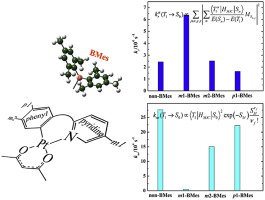Organic Electronics ( IF 2.7 ) Pub Date : 2017-09-06 , DOI: 10.1016/j.orgel.2017.09.004 Ming-Shuo Ma , Ai-Min Ren , Lu-Yi Zou , Lu Shen , Xiao-Li Ding , Yan Li , Hong-Xing Zhang

|
The radiative and non-radiative decay processes of four cyclometalated (C∧N*)Pt(II)(acac) complexes were investigated by using the density functional theory/time dependent density functional theory (DFT/TD-DFT) approach. In order to explore the influence of the BMes2 moiety on the quantum yields of complex (ppy)Pt(acac) (ppy = 2-phenylpyridine, acac = acetylacetonate), the radiative process was determined by calculating the spin orbital coupling (SOC) as well as zero-field-splitting (ZFS) parameters. In addition, the SOC matrix elements between T1 and S0 state, the Huang-Rhys factor, the degree of vibronic coupling between S0 and T1 states were also computed to describe the non-radiative decay process. The results show that, the fatal factor to the low phosphorescence quantum yields in complex Pt(ppy)(acac) is a fast non-radiative decay caused by a large Huang-Rhys factor (SM) and the maximum reorganization energy appearing in the high frequency range. However, the introduction of the BMes2 moiety, a bulky and featuring strong electron-withdrawing character and vacant p-orbital of B atom, could decrease the values of Huang-Rhys factor by suppressing the C-C stretching vibrations in the ppy ligand, inhibiting the non-radiative decay process. Besides, for complex 2, the introduction of the BMes2 group into the meta-position of the pyridine ring in C∧N chelate, added the π(aryl)-p(B) delocalization interaction, resulting in a large ZFS and kr, a small 〈S0|HSOC|T1〉2, the square value of coupling matrix between the ground state S0 and the lowest triplet state T1, thus leading to its quantum yield is superior to the other complexes.
中文翻译:

上的环金属化的磷光量子产率的理论研究(C ∧ N *)铂(II)(ACAC)配合物:所述BMES的位置的影响2部分上的辐射和非辐射衰变过程
利用密度泛函理论/时间依赖密度泛函理论(DFT / TD-DFT)方法研究了四种环金属化的(C∧N *)Pt(II)(acac)配合物的辐射衰变过程和非辐射衰变过程。为了探讨BMes 2部分对复合物(ppy)Pt(acac)(ppy = 2-苯基吡啶,acac =乙酰丙酮酸酯)的量子产率的影响,通过计算自旋轨道耦合(SOC)确定了辐射过程以及零场分裂(ZFS)参数。此外,T 1和S 0之间的SOC矩阵元素的状态,Huang-Rhys因子,S 0和T 1之间的振动耦合程度还计算了态来描述非辐射衰变过程。结果表明,复杂的Pt(ppy)(acac)中磷光量子产率较低的致命因素是大量的Huang-Rhys因子(S M)引起的快速非辐射衰变,并出现了最大的重组能。高频范围。但是,引入BMes 2部分(其体积大且具有强大的吸电子特性和B原子的空p轨道)的引入,可以通过抑制ppy配体中的CC拉伸振动来降低Huang-Rhys因子的值,从而抑制ppy配体的形成。非辐射衰减过程。此外,对于复合物2,将BMes 2组引入元在C中的吡啶环的位上∧ Ñ螯合物,添加π(芳基)-p(B)的离域相互作用,导致大ZFS和ķ - [R ,小<S 0 | H SOC | T 1 > 2,所述基态S 0和最低三重态T 1之间的耦合矩阵的平方值,从而导致其量子产率优于其他配合物。











































 京公网安备 11010802027423号
京公网安备 11010802027423号